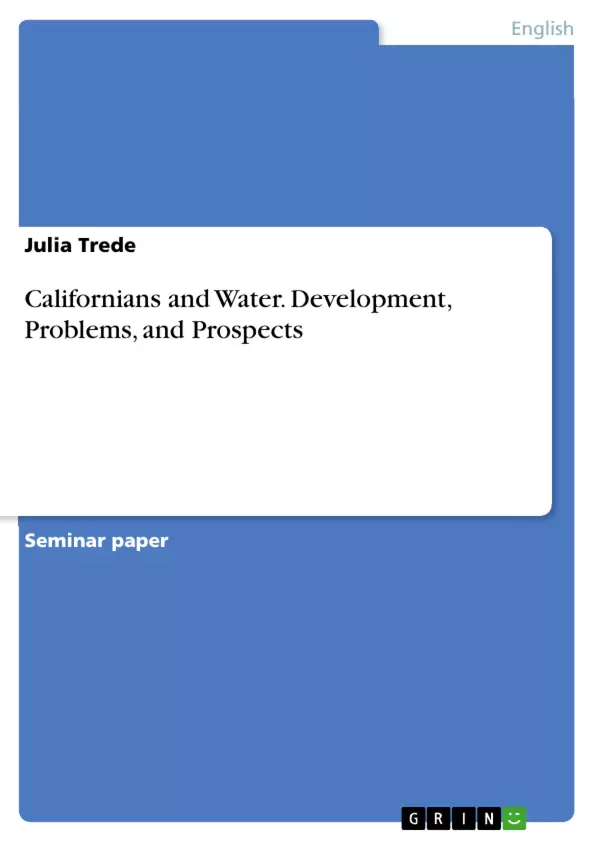Water in California is a political issue. It is always in the wrong place at the wrong time. In springtime, when there is enough precipitation, the snowmelt from the Sierra Nevada floods valleys and fields. And during summer when farmers need the water the land is dry. Additionally, the North commands over three quarters of the water while the South consumes 80 % of it. Therefore, the state pumps water from a gigantic basin called the Sacramento San Joaquin River Delta to the thirsty South. This was not invariably the case four hundred years ago when Native Californians inhabited California. Its waterscape differed markedly from that of todays and changed significantly while undergoing the Spanish Conquest and the American Takeover. After recognizing the value of water a fight over water emerged still leading political debates today.
This research paper deals with Californian’s and water, examining problems, developments and prospects of water distribution and consumption. It provides an overview of the history of California’s waterscape and its manipulation by different races. The first chapter deals with the Native Californians and their reception of nature followed by the Spanish who brought a completely different set of values to the country and finally the American Conquest introducing a new era of water consumption. These elaborations are based on Norris Hundley’s comprehensive work The Great Thirst: Californians and Water as it provides incisive descriptions and explanations encompassing two centuries of water problems in California.
The second chapter illustrates California’s water use and explains the different sectors trying to examine where the highest amount of water is being consumed. The distribution of water and different water projects are subject to the third chapter. This paragraph explains the Central Valley Project such as the State Water Project and identifies problems and consequences. Subsequently, problems of California’s water supply are highlighted and possible solutions are elaborated. Chapters 2 – 5 are based on information provided by the Department of Water Resources which provides a detailed schedule of annual Water Plan updates on its website.
Inhaltsverzeichnis (Table of Contents)
- Introduction
- 1. The History of Water in California
- 1.1. Aboriginal Waterscape
- 1.2. Hispanic Patterns
- 1.3. American Takeover
- 2. Water Use in California
- 2.1. Environmental Use
- 2.2. Agriculture Use
- 2.3. Urban Use
- 3. Distribution of Water and Water Projects
- 3.1. Central Valley Project
- 3.2. State Water Project
- 3.3. Consequences of Water Projects
- 4. Problems of Water Supply
- 5. Prospects and Measures Adopted to Reduce Water Problems
- Conclusion
Zielsetzung und Themenschwerpunkte (Objectives and Key Themes)
This research paper explores the complex relationship between Californians and water, examining the historical development, current problems, and future prospects of water distribution and consumption in the state. It aims to provide a comprehensive overview of the historical changes in California's waterscape, highlighting the different approaches to water management by Native Californians, Spanish colonizers, and American settlers.
- The historical transformation of California's waterscape from an aboriginal to an industrialized one.
- The diverse ways in which different cultures have viewed and managed water resources.
- The distribution and consumption of water in different sectors of California's economy, including agriculture, urban use, and the environment.
- The challenges and consequences of large-scale water projects, such as the Central Valley and State Water Projects.
- The ongoing problems of water supply in California and potential measures to address these challenges.
Zusammenfassung der Kapitel (Chapter Summaries)
The first chapter delves into the history of California's waterscape, contrasting the native approach to water management with the European conquest. It focuses on the indigenous perspective, emphasizing their respect for nature and harmonious coexistence with the environment. It explores how the Spanish and American settlers drastically altered the landscape by introducing large-scale water manipulation.
The second chapter focuses on the current state of water use in California, exploring the different sectors that consume the majority of water resources. It examines environmental use, agricultural use, and urban use, providing insights into the distribution and consumption patterns within each sector.
The third chapter discusses the distribution of water and the various water projects implemented in California. It explores the Central Valley Project, the State Water Project, and their significant consequences, including both positive and negative impacts on the environment and society.
The fourth chapter addresses the pressing problems of water supply in California, highlighting the challenges and complexities associated with water scarcity and allocation.
Schlüsselwörter (Keywords)
The key concepts and terms examined in this research paper include the history of California's waterscape, Native Californians, Spanish conquest, American takeover, water use and distribution, environmental use, agriculture use, urban use, Central Valley Project, State Water Project, water supply problems, and sustainable water management.
- Citation du texte
- Julia Trede (Auteur), 2013, Californians and Water. Development, Problems, and Prospects, Munich, GRIN Verlag, https://www.grin.com/document/511359



